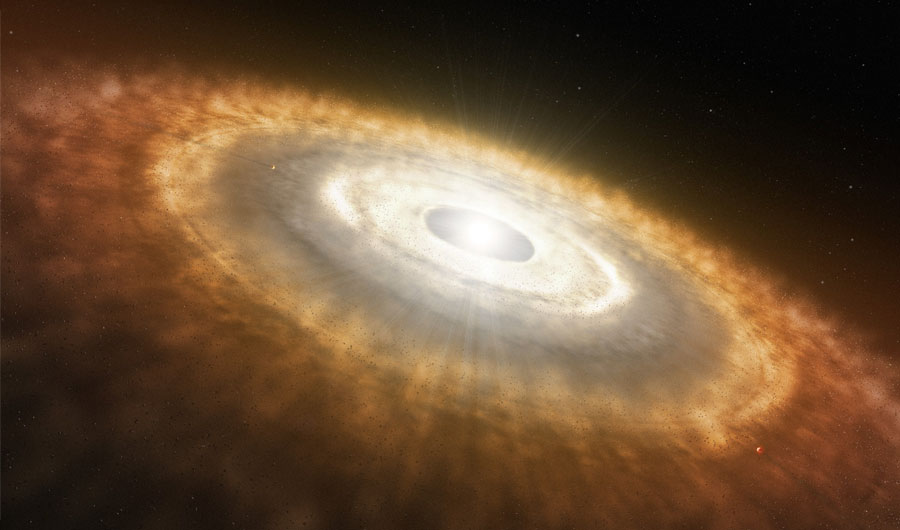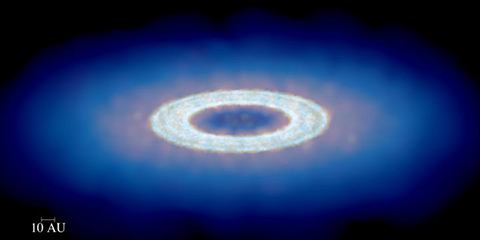Planets May Grow from 'Dust Traps' Around Stars

Artist’s impression of a baby star still surrounded by a protoplanetary disk.
(Inside Science) -- At home, dust traps might mean extra cleaning. But in space, dust traps could be key to making planets.
Trapping dust around newborn stars can coax the particles to stick together and grow into planets. Using computer simulations, scientists have found a new way to produce these dust traps, which could help solve a long-standing mystery of how planets form.
Planetary systems, including our own solar system, develop from a disk of gas and dust that circles a new star. In this protoplanetary swirl, tiny dust grains smaller than red blood cells cling together and grow. But when they reach roughly the size of a pebble, calculations show that they should run into problems.
At that size, a particle becomes susceptible to drag forces from the surrounding gas, like a cyclist trying to pedal through a headwind. The particle should slow down and spiral inward, plunging into the star before it has any chance of growing into a planet.
But that can't be happening. Buoyed by the discovery of thousands of exoplanets so far, astronomers know that planets are commonplace, with estimates of a hundred billion in our galaxy alone. Somehow, these pebble-sized particles readily amass into planets -- a puzzle that has perplexed scientists for 40 years.
Now it seems that at least part of the explanation may lie in dust traps, according to a team of researchers from France, the U.K. and Australia.
"We've shown that it's way easier than previously assumed to form these traps," said Jean-François Gonzalez of the Centre de Recherche Astrophysique de Lyon in France, lead author of the study recently published in the Monthly Notices of the Royal Astronomical Society. "They should be a very common feature of protoplanetary disks, and so are a very easy way to form large objects."
The traps arise when the gas slows the dust and forces it inward. But every action has an equal and opposite reaction, according to Newton's third law. So while the dust moves inward, the gas, which orbits the star with the dust, gets pushed outward.
This back reaction, Gonzalez said, is something most previous computer simulations of disks ignored. And simulations that did include it just focused on smaller portions of the disk.
Those small-scale simulations wouldn't have shown how the pushed gas bunches up and forms a ring-shaped region of high pressure around the star. It turns out that this high-pressure gas traps other dust particles and gets them to stick to one another, Gonzalez explained. Once they aggregate into a planetesimal -- an embryonic planet about the size of an asteroid -- their gravity is strong enough to accrue more mass and become a full-fledged planet.
"It's a new way to think about how pebbles might slow down and stay in the outer regions of the disk," said Katherine Kretke, an astrophysicist at the Southwest Research Institute in Colorado. "It needs to be considered in the suite of options of what's probably going on in disks."
Indeed, this new process complements a previous idea proposed more than ten years ago, Gonzalez said. That idea, which is the main explanation to date for how dust particles might become planets, involves a phenomenon called the streaming instability. In that process, the headwind from the gas forces dust particles to congregate and merge, like cyclists clustering to minimize drag.
Still, the story of how planets form is far from settled. Some researchers are even arguing that this new dust-trap idea is just another version of the streaming instability, Daniel Price, an astrophysicist at Monash University in Australia who was not involved in the study, said in an email.
One potential problem is how the new simulations treat turbulence, said Gregory Laughlin, an astrophysicist at Yale University. While the analysis assumes the disk is viscous, a property that would result from vortices and eddies in turbulent flow, it does not directly model those phenomena. This could mean the simulation doesn't capture how turbulence affects planetesimal formation. That's not to say the new study is necessarily wrong, he said -- just that more work probably needs to be done, and that the problem is inherently complex.
It also doesn't help that there's not much observational evidence to inform simulations. Although the Atacama Large Millimeter Array telescope in Chile has seen protoplanetary disks with ringlike features -- structures that could be the hypothesized dust traps -- current instruments can't reveal enough detail to show exactly how dust grows into planets.
"I would be surprised," Laughlin said, "if this is the last word on how planetesimals form."


